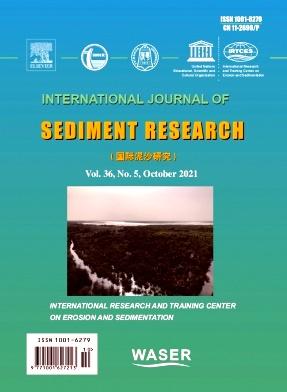Impact of emergent vegetation on three-dimensional turbulent flow properties and bed morphology in a partially vegetated channel
IF 3.7
2区 环境科学与生态学
Q2 ENVIRONMENTAL SCIENCES
引用次数: 0
Abstract
The study aimed to explore three-dimensional turbulent flow properties and bed morphology in a partially vegetated channel with sand bed conditions. Presence of flexible vegetation in the river and its interaction with the flow are of great significance in understanding the momentum and mass transport in the flow. Experiments were conducted in a straight, tilting rectangular flume with staggered emergent vegetation covering half of the channel width. The results show that the presence of vegetation diverts streamwise velocity from the vegetated side to the non-vegetated side. The study reveals that the presence of vegetation leads to an increase in turbulent intensity, turbulent kinetic energy, and Reynolds shear stress at the transition area between the vegetated and non-vegetated sides of the channel. This increase is attributed to higher transverse flow and momentum exchange in the transition area between the vegetated and non-vegetated sides. In the vegetated side, the vegetation serves as an obstruction, reducing turbulent intensity, turbulent kinetic energy, and Reynolds shear stress compared to the transition area between the vegetated and non-vegetated sides. This reduction in turbulence supports the stability of bed materials and promotes sediment deposition. The presence of vegetation significantly alters the secondary current in the channel. Scour depth along the non-vegetated side was higher than the vegetated side, mainly because the flow concentrated in the centre and non-vegetated side of the channel. The investigation determines that the existence of vegetation on the vegetated side effectively protects against bed erosion and sediment transport. Understanding the impact of emergent flexible vegetation on flow properties and sediment transport can inform decisions about vegetation layouts in river ecosystems.
新兴植被对部分植被河道三维湍流特性和河床形态的影响
本研究旨在探索部分植被河道砂床条件下的三维湍流特性和河床形态。河流中柔性植被的存在及其与水流的相互作用,对于理解水流动量和质量输运具有重要意义。实验是在一个直的、倾斜的矩形水槽中进行的,交错的植被覆盖了一半的通道宽度。结果表明,植被的存在使水流速度从植被侧向非植被侧转移。研究表明,植被的存在导致河道两侧植被侧和非植被侧过渡区域湍流强度、湍流动能和雷诺剪切应力增大。这种增加是由于植被侧和非植被侧之间过渡区域的横向流动和动量交换增加。在植被侧,相对于植被侧和非植被侧的过渡区域,植被起到了阻碍作用,降低了湍流强度、湍流动能和雷诺数剪切应力。湍流的减少支持了河床物质的稳定性,促进了沉积物的沉积。植被的存在显著地改变了河道中的二次流。无植被侧冲刷深度大于无植被侧,主要原因是水流集中在河道中心和无植被侧。调查确定,植被侧植被的存在有效地防止了河床侵蚀和泥沙运移。了解涌现的柔性植被对水流特性和沉积物输运的影响可以为河流生态系统中植被布局的决策提供信息。
本文章由计算机程序翻译,如有差异,请以英文原文为准。
求助全文
约1分钟内获得全文
求助全文
来源期刊
CiteScore
6.90
自引率
5.60%
发文量
88
审稿时长
74 days
期刊介绍:
International Journal of Sediment Research, the Official Journal of The International Research and Training Center on Erosion and Sedimentation and The World Association for Sedimentation and Erosion Research, publishes scientific and technical papers on all aspects of erosion and sedimentation interpreted in its widest sense.
The subject matter is to include not only the mechanics of sediment transport and fluvial processes, but also what is related to geography, geomorphology, soil erosion, watershed management, sedimentology, environmental and ecological impacts of sedimentation, social and economical effects of sedimentation and its assessment, etc. Special attention is paid to engineering problems related to sedimentation and erosion.

 求助内容:
求助内容: 应助结果提醒方式:
应助结果提醒方式:


